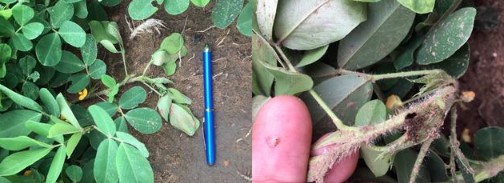By Barry Tillman
Earlier this week, lesser cornstalk borer (LCB) damage was observed in Suwanee, Columbia, and Marion counties in Florida. In all cases, the peanut vines had not lapped, and the only symptom found was wilting vines at the ground level (Figure 1). When lifting the wilted vine, the entry/exit hole made by the LCB was visible. Dr. Mark Abney, University of Georgia entomologist kindly provided information below to help make decisions regarding control of this pest. Based on the damage and stage of growth, the general recommendation is to treat non-irrigated fields that have not lapped and have 30% LCB damage incidence. That means that LCB damage is present in 3 out of 10 random three-foot sections of row. It may be advisable to treat irrigated fields, if the plants are young (a ways from lapping) but meet this threshold, especially if it is hot and the row middles are subject to dry out.

Figure 1. Left- wilted vine tips caused by the lesser cornstalk borer damage in peanut in Marion County, FL. June 21, 2018. Right – entry/exit hole left by the LCB on the underside of the stem along with the remnants of the silk tube made by the insect.
Dr. Abney’s Answers to common questions about Lesser Cornstalk Borer (LCB) in Peanuts
1.What is a lesser cornstalk borer and why should you care?
Lesser cornstalk borer (LCB) is one of the most damaging insect pests of peanut, and there have been many reports of LCB in Florida and Georgia peanut fields already in 2018. LCB is a caterpillar pest that bores into peanut stems, crowns, and pods. Feeding can reduce yield directly and increase the risk of aflatoxin. Figure 2 shows a LCB larva and moth.
Figure 2. Left- Large LCB larva in the main stem of a peanut plant. Right- Male LCB moth.
2. What fields are at risk for lesser infestation?
LCB can infest any peanut field at any stage of development, BUT…later planted, non-irrigated, low moisture, or sandy peanut fields are at increased risk of infestation. LCB thrives under hot, dry conditions.
3. Will lessers go away if it rains?
Maybe… If wet weather continues for a prolonged period you can expect lesser populations to decline. Mortality of LCB caterpillars is always high, but it is much higher when the soil is cool and moist. Given the wet conditions we have experienced in 2018 the high levels of LCB populations that are present in some peanut fields is surprising. This is a good reminder that with insects, very little is certain. We have a long way to go before harvest. If hot, dry conditions return/persist, we could be in for a severe LCB outbreak.
4. I am finding LCB in my irrigated peanut fields. What should I do?
It is not uncommon to find LCB in irrigated peanut fields early in the season before the vines lap. LCB infestations in adequately irrigated peanuts tend to decline pretty quickly once the row middles close. The decision to treat LCB in irrigated fields prior to row closure is a judgment call. We need to consider the size of the pest population and the extent of the damage. Early season feeding in the main stem can reduce yield and may increase susceptibility to soil-borne pathogens.
5. Should I treat my non-irrigated fields for LCB?
It depends. I would not treat fields that have received significant rainfall over the last two weeks just because moths are present; however, fields that are dry, beginning to peg and have active LCB infestations will probably benefit from treatment.
If it gets dry, there will be a point later this summer when growers are going to ask this question about fields that have virtually no chance of making a crop of peanuts. Knowing when to “walk away” is tough, and making the decision to do so can be even tougher.
6. What insecticide should I use to manage LCB?
UGA research trials have shown that Prevathon (chlorantraniliprole) at 16 fl oz/acre, Diamond (Novaluron) at 6-9 fl oz/acre, and Besiege (chlorantraniliprole + lambda cyhalothrin) at 10 fl oz/acre can reduce LCB populations and damage.
Dr. Abney strongly cautions against using pyrethroids in non-irrigated peanut unless absolutely necessary. Pyrethroids will reduce beneficial insects that limit population growth of foliage feeding caterpillars and spider mites later in the season. Be aware that Besiege contains a pyrethroid. Dimilin (diflubenzuron) is also not recommended for LCB control.
Click here to see more...